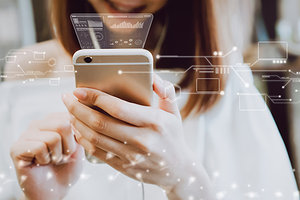Just over three years ago, I wrote an article pointing to some emerging technological breakthroughs that could dramatically change the course of health care.1 Today, much of what was dreamed about then is already in process.
A year after I shared my thoughts, we saw articles talking about how Watson, IBM's cognitive supercomputer, was helping medical doctors diagnose cancer in patients when their traditional diagnoses had failed.2 Artificial intelligence (AI) is proving itself in health care and making great strides in a short period of time.
It will not be too much longer until a single pill becomes the source of critical data on your patients' health from the inside. This could open the door to a greater understanding of your patients' nutritional needs or what drug they might be prescribed next.
For those of you who still remember the Star Trek "tricorder," you no doubt recall the scenes in which Dr. McCoy scanned a living being (not necessarily human) and instantly received data on their condition. The device would collect data, analyze it and provide a diagnosis of the illness (or injury, depending on the plot line). Today, the "tricorder" has essentially been replaced by what we call a smartphone.
The Smartphone Potential
 A Bluetooth-connected molecular sensor called SCiO was introduced at last year's Consumer Electronics Show (CES). The device is built into certain smartphones to analyze the chemical composition of food. You can also scan your body to determine your body mass index (BMI).
A Bluetooth-connected molecular sensor called SCiO was introduced at last year's Consumer Electronics Show (CES). The device is built into certain smartphones to analyze the chemical composition of food. You can also scan your body to determine your body mass index (BMI).
This year's CES saw a host of wearable devices that connect with your patients' smartphones to monitor calorie intake, sleep quality, calories burned, hydration level and stress level. There are now small skin patches that will monitor "all of the biometrics" in your body. This year, almost 50 million wearable devices will be sold to consumers, creating a $6 billion market. Some technology advances are targeting specific ailments, such as diabetes. Others are simply impacting lifestyle and/or addressing pain management.
Much of the conversation at this year's CES centered around how to share data between providers. Termed "healthcare's largest roadblocks," data management and analytics will drive the conversation in the growing use of health data for the next several years. When the dust settles, you will have access (if you choose) to a host of information generated by these devices, sent to you from your patients' smartphones or shared through a provider network. Not too long after that, your patients will be asking about how you are incorporating this data into your / their care plans.
It is not unreasonable to think that a smartphone-enabled breathalyzer, retina scanner and blood analyzer will replace initial visits, physical exams and much of the lab work that keeps general medical practitioners in business. Add in the monthly consumption of an ingestible sensor and you could generate more patient data at home than most hospital labs could generate in a week.
Where Does This Leave DCs?
I believe all of this data crunching could be of great benefit for chiropractic. With the right data input devices, there is no reason why an app can't detect a subluxation and let both the patient and the chiropractor know when it's time for an appointment.
It's also not unreasonable to expect that a large enough dataset will ultimately tell us more about the subluxation than we have every known or understood. The app could potentially provide a three-dimensional model of the effected spinal segment, along with the associated ligaments and muscles.
The input devises could include shoes, orthotics, a laser gait analysis tool and even the living-room floor of a "smart" home. Or it could include an interface not even thought of yet.
As a doctor in this rapidly changing world, you would be well-served to get involved in the health-data process now so you are familiar with how it can serve you and your patients as it evolves. This can be accomplished with a wearable device like a smart watch or a fitness tracker. You may also want to read a few articles on the latest trends.
The adoption of these devices is being driven by employers who are seeing savings in their self-funded health plans. The Corporate Health & Wellness Association produced a presentation in mid-2016 that will provide you with their point of reference.4
This is another opportunity, but only if the chiropractic profession gets involved in solutions. If not, another profession might be more than happy to lead the way. The question is up to us to answer as to whether there will be a chiropractic app on every smartphone.
References
- Petersen Jr. D. "Welcome to 2015 – The Year to Embrace Change." Dynamic Chiropractic, Jan. 1, 2015.
- Feldman M. "Watson Proving Better Than Doctors at Diagnosing Cancer." Top 500, Aug. 9, 2016.
- "Otsuka and Proteus Announce the First U.S. FDA Approval of a Digital Medicine System: ABILIFY MYCITE® (aripiprazole tablets with sensor)." Otsuka Pharmaceutical Co., Ltd. Nov. 14, 2017.
- "The State of Wearables in the Workplace." Corporate Health & Wellness Association. June 1, 2016.
Read more findings on my blog: http://blog.toyourhealth.com/wrblog/. You can also visit me on Facebook.
Click here for more information about Donald M. Petersen Jr., BS, HCD(hc), FICC(h), Publisher.





